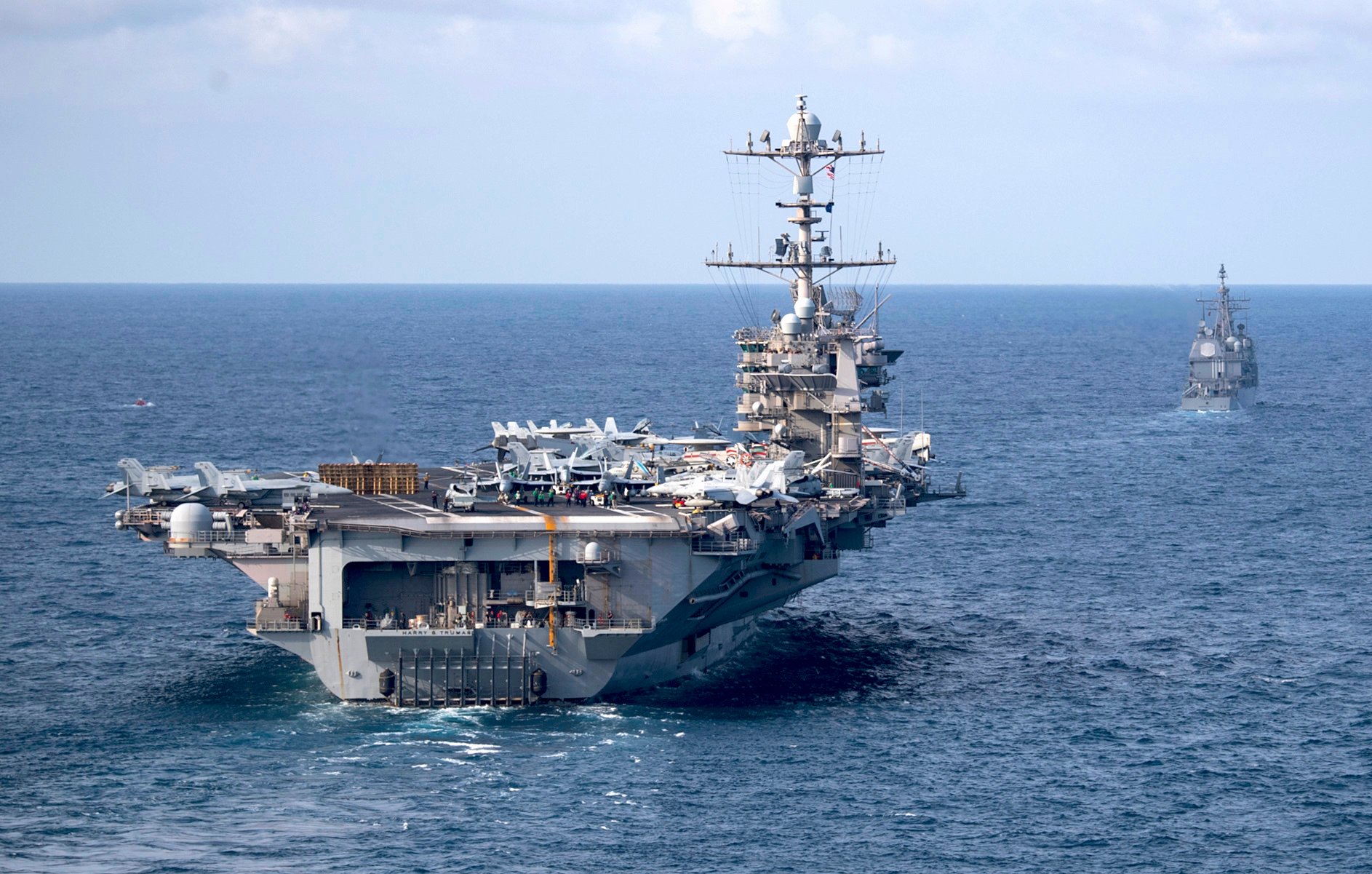
USS Harry S. Truman (CVN-75), front, and the Ticonderoga-class guided-missile cruiser USS Normandy (CG-60) transit the Atlantic Ocean on July 18, 2019. US Navy Photo
Aircraft carrier USS Harry S. Truman (CVN-75) is repaired and preparing to deploy, after extensive electrical issues sidelined the carrier from its scheduled September deployment date.
Truman and its carrier strike group had completed a final certification event, the composite training unit exercise (COMPTUEX), and were preparing to head out on deployment around Labor Day, when the carrier suffered “electrical malfunction within the ship’s electrical distribution system requiring analysis and repair,” the Navy told USNI News in late August.
Since that time, a range of personnel – including from the ship’s crew and the nearby Norfolk Naval Shipyard repair facility – have been working to get the electrical distribution system back up and running.
“Returning HST to full functionality was a team effort with a tremendous amount of work and collaboration by NAVSEA, our industry partners, shipyard workers, and the crew of HST to overcome a very challenging technical issue,” Naval Sea Systems Command commander Vice Adm. Tom Moore said in a statement provided to USNI News by U.S. Fleet Forces Command.
USNI News previously reported that some enlisted sailors were forced out of their berthing spaces on the ship due to the lack of power and were living in hotels near the naval station. Repairs have continued since the late August recognition of the problem, with a source telling USNI News that new problems continued to arise as personnel opened up new electrical panels.
In mid-September, three destroyers and a cruiser meant to operate under the Truman Carrier Strike Group deployed instead as a surface action group (SAG) under U.S. 2nd Fleet command until the carrier could get out to sea. The SAG immediately went north to Iceland, where the ships were able to conduct surface and anti-submarine warfare activities before heading to the Middle East.
Those ships are now escorting USS Abraham Lincoln (CVN-72), whose deployment has been extended until Truman can replace it. Lincoln has been hovering outside the Persian Gulf since the spring, when tensions between Iran and the U.S. and European nations spiked. Lincoln’s surface ships in the past weeks departed U.S. 5th Fleet and returned to their homeport in Virginia, and Truman’s escorts took their place protecting Lincoln. Once Truman tags in, Lincoln will be able to continue its round-the-world deployment and move from its old homeport of Norfolk, Va., to San Diego, Calif.
The Navy would not confirm plans for Truman’s deployment. A source told USNI News that the carrier would deploy early next week, though it is unclear if the ship will be cleared for operations by that time. USNI News understands that Truman will not need to do another COMPTUEX before being declared ready to deploy, but the ship will have to take other steps to prove to U.S. 2nd Fleet that it is operationally ready to deploy after sitting pierside for two and a half months.
Asked what the process would look like to get Truman cleared to deploy, 2nd Fleet spokeswoman Lt. Marycate Walsh told USNI News that “the carrier strike group has maintained a high level of readiness since returning from deployment in December 2018 and have recently completed carrier qualifications aboard USS John C. Stennis (CVN-74). As a matter of longstanding policy, we do not discuss future operations. Every effort is being made to make the carrier, air wing, and sailors operationally ready to deploy.”
This deployment will be Truman‘s second in two years, after a 2018 deployment.
The East Coast fleet is facing a shortage of available carriers. Truman will conduct this double-pump deployment and then have to go into maintenance upon returning next year. USS George H.W. Bush (CVN-77) is near the front end of a 28-month maintenance availability, and USS George Washington (CVN-73) and John C. Stennis are in and preparing for their mid-life refuelings, respectively, which take about two years to prepare and four years to conduct. With Lincoln having departed the East Coast for a new homeport in California, this leaves just USS Dwight D. Eisenhower (CVN-69) to cover East Coast carrier deployments for the time being, with USS Gerald R. Ford (CVN-78) still years from its maiden deployment.
The following is the complete statement from U.S. Fleet Forces Command:
Repairs to the USS Harry S. Truman (CVN 75) are complete, and all efforts are being made to return the carrier and air wing to sea to conduct operations.
In August, the Navy announced an emergent maintenance requirement for an electrical issue aboard Truman. The Navy replaced damaged components and completed tests to ensure no further issues will arise. An engineering analysis, coupled with inspections aboard several aircraft carriers, show that this was a localized issue and not a class-wide concern. The success of this repair was due to the outstanding efforts of multiple Navy organizations and industry partners who quickly brought their expertise and skills to bear to resolve this issue.
“Returning HST to full functionality was a team effort with a tremendous amount of work and collaboration by NAVSEA, our industry partners, shipyard workers, and the crew of HST to overcome a very challenging technical issue,” said Commander, Naval Sea Systems Command, Vice Admiral Thomas Moore.
Every effort is being made to make the carrier, air wing, and Sailors operationally ready to deploy.
